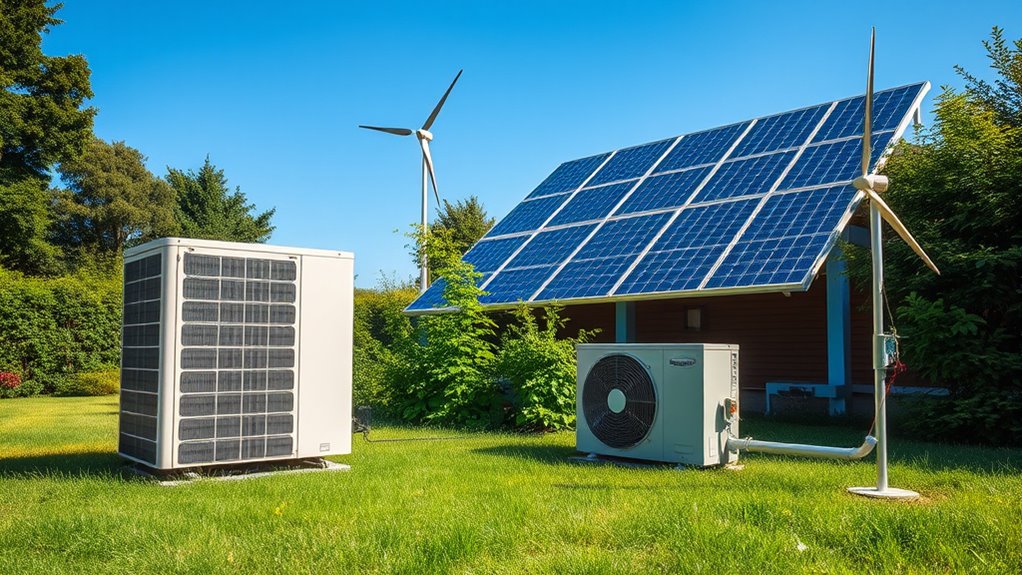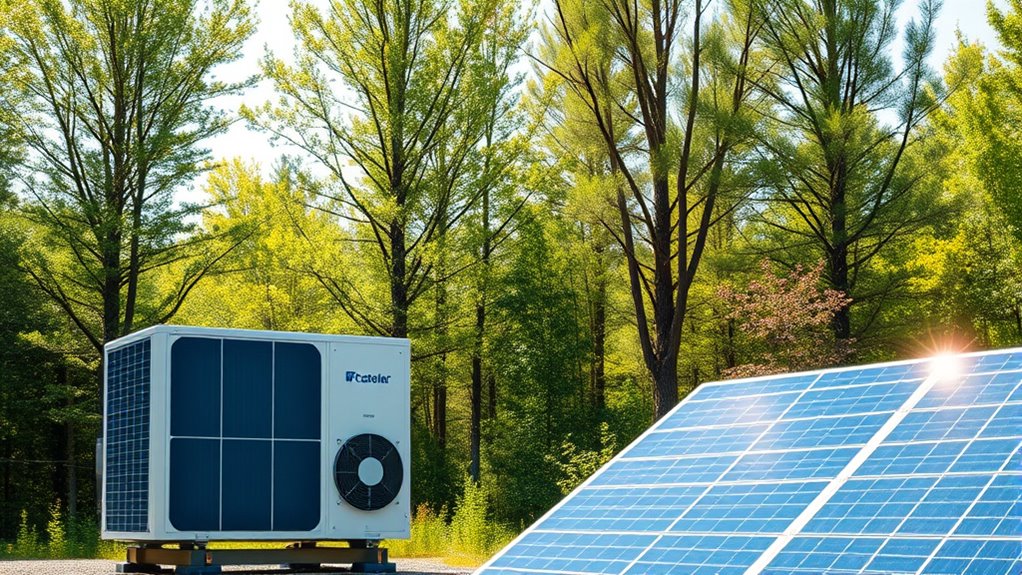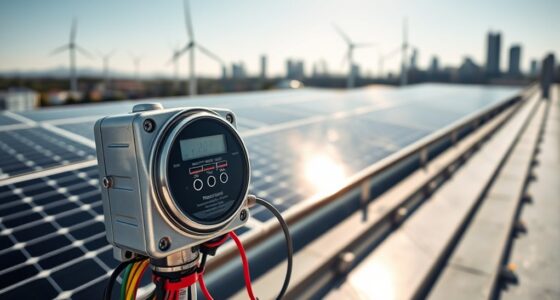Pairing heat pumps with renewable energy sources like solar and geothermal helps you attain maximum efficiency in your home. Solar panels can provide free, clean electricity, while geothermal taps into stable underground temperatures for reliable heating and cooling. Combining these systems creates a resilient, eco-friendly setup that lowers your energy costs and reduces reliance on fossil fuels. This integrated approach ensures consistent comfort and savings—continue exploring to discover how you can optimize your home’s energy performance even further.
Key Takeaways
- Combining heat pumps with solar and geothermal energy maximizes efficiency and reduces reliance on fossil fuels.
- Geothermal integration provides a stable underground heat source, enhancing heat pump performance year-round.
- Solar panels supply renewable electricity to heat pumps, decreasing grid dependence and operational costs.
- Hybrid systems leverage both solar and geothermal energy for resilient, eco-friendly heating and cooling.
- This integrated approach lowers carbon footprint, promotes sustainability, and can qualify for financial incentives.

Have you ever wondered how to make your home heating more sustainable? If so, pairing heat pumps with renewable energy sources offers a smart solution. By combining these technologies, you can markedly reduce your carbon footprint while enjoying reliable, efficient heating. One of the key aspects to consider is geothermal integration. This involves using the stable underground temperature to power your heat pump, which enhances efficiency and diminishes reliance on fossil fuels. Geothermal systems tap into the earth’s natural heat, providing a consistent energy source regardless of seasonal changes, and when paired with a heat pump, they create a highly efficient heating and cooling system. This integration not only cuts operational costs but also boosts the sustainability of your home. Additionally, understanding seed allergy risks can be important if you’re considering incorporating natural or organic components into your home environment to promote overall wellness.
Another crucial factor is solar compatibility. Solar panels can be seamlessly integrated with heat pump systems to generate renewable electricity that powers your heating and cooling needs. When your home’s energy demands are met mainly by solar power, you drastically lower your reliance on grid electricity, which often still relies heavily on fossil fuels. Installing solar panels alongside your heat pump ensures that you’re harnessing free, abundant sunlight to operate your heating system, making your entire setup more eco-friendly. Many modern heat pumps are designed with compatibility in mind, allowing easy integration with existing solar arrays or future solar upgrades. This synergy maximizes energy independence and reduces ongoing costs, as your home essentially becomes a mini renewable energy hub.
Thinking about geothermal integration and solar compatibility together reveals a powerful pathway toward ultimate efficiency. When your heat pump is powered by solar energy and supplemented by geothermal heat exchange, you’re creating a system that’s both resilient and eco-conscious. During sunny days, your solar panels can provide ample power to run your heat pump, while geothermal energy maintains consistent indoor temperatures even when the sun isn’t shining. This hybrid approach minimizes energy waste and ensures continuous comfort. Furthermore, integrating these technologies may qualify you for various incentives or rebates, making the initial investment more affordable.
Frequently Asked Questions
What Are the Long-Term Cost Savings of Pairing Heat Pumps With Renewables?
You’ll see significant long-term cost savings by pairing heat pumps with renewable energy sources. This setup reduces your energy bills since renewables like solar power lower operational costs. Over time, the investment return increases as energy prices rise and maintenance remains low. Plus, you contribute to a greener future. Overall, this combination offers a smart, sustainable way to save money while enjoying reliable, efficient heating and cooling.
How Do Weather Fluctuations Impact Renewable-Powered Heat Pump Performance?
Weather fluctuations can throw a wrench in your plans, especially with renewable-powered heat pumps. You’ll notice solar variability and temperature fluctuations impacting performance, making it harder to depend solely on renewables. While heat pumps adapt, their efficiency dips during cloudy days or extreme cold, so you might need backup systems. Planning for these ups and downs ensures your heating stays reliable, even when Mother Nature doesn’t cooperate.
Are There Specific Regions Best Suited for This Pairing?
You should consider climate suitability and geographic advantages when choosing regions for this pairing. Areas with consistent sunlight and wind, like parts of California or Northern Europe, naturally support renewable energy sources. These regions experience moderate temperatures, reducing strain on heat pumps and improving efficiency. By focusing on locations with favorable climate conditions and geographic advantages, you optimize performance and guarantee a more reliable, sustainable system.
What Maintenance Is Required for Renewable Energy-Powered Heat Pumps?
A stitch in time saves nine, so regular system maintenance keeps your renewable energy-powered heat pump running smoothly. You should routinely check filters, clean coils, and inspect electrical connections. Be prepared for occasional component replacement, like thermostats or compressors, to ensure efficiency and longevity. Staying proactive prevents costly repairs and maximizes your system’s performance, helping you get the most out of your investment.
How Does This Pairing Affect Overall Carbon Footprint Reduction?
You’ll see significant carbon reduction when you pair heat pumps with renewable energy sources. This combination boosts sustainability benefits by minimizing reliance on fossil fuels, reducing greenhouse gas emissions, and lowering your overall carbon footprint. By using clean energy, your heat pump operates more efficiently, helping you contribute to environmental preservation while enjoying cost savings. It’s a smart, eco-friendly choice that aligns with your goal of a greener, more sustainable future.
Conclusion
By pairing heat pumps with renewable energy, you’re opening the door to a greener future, where your home breathes in clean power and exhales warmth efficiently. Imagine your energy system as a well-tuned symphony, harmonizing sustainable sources with cutting-edge technology. Together, they create a ballet of innovation and environmental care, turning your everyday comfort into a powerful act of planet-saving. Embrace this pairing, and watch your home become a beacon of renewable hope.









